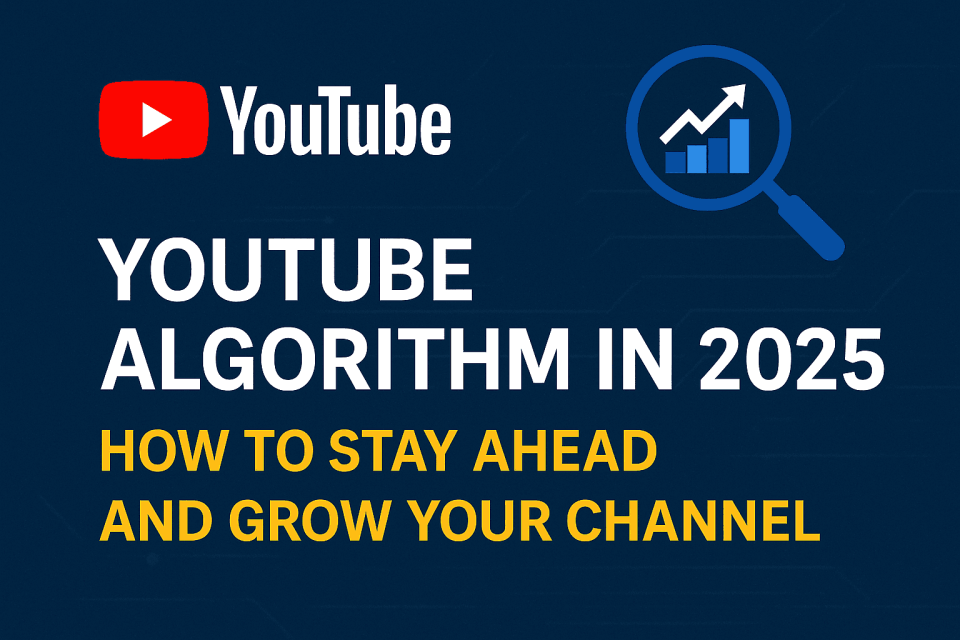The YouTube algorithm is constantly evolving, and as we approach 2025, the changes are expected to be even more significant.
YouTube has already shifted the way it ranks content, with a focus on watch time, user engagement, and now, AI-driven recommendations. So, how can creators stay ahead and grow their channels in this ever-changing environment?
In this blog, we’ll explore the key changes expected in the YouTube algorithm by 2025 and share strategies to help you boost your channel’s visibility, engagement, and growth.
1. The Rise of AI and Machine Learning in Content Discovery
As YouTube’s algorithm becomes more sophisticated, AI and machine learning will continue to play a huge role in content discovery.
By 2025, YouTube will have refined its AI tools to deliver more personalized and relevant content to users, not just based on their viewing history, but also by analyzing user preferences in real time.
AI will focus on user intent, meaning YouTube will understand what a viewer actually wants, even before they start watching. This will lead to even more targeted recommendations, and the videos that align with specific viewer needs and interests will gain better visibility.
How to Adapt:
Optimize for Intent: Tailor your titles, descriptions, and tags to match what your audience is actively searching for and the types of content they typically watch.
Use Advanced AI Tools: Leverage AI-powered tools for video optimization and analytics to track viewer behavior and fine-tune your content accordingly.
2. Enhanced Focus on Audience Engagement
By 2025, audience engagement will be an even stronger ranking factor for YouTube. Beyond just likes, comments, and shares, the platform will begin factoring in deeper engagement metrics like time spent interacting with the content (e.g., whether viewers are clicking on cards, exploring other videos in your channel, or commenting in-depth).
How to Adapt:
Create Engaging Content: Focus on creating high-quality content that encourages viewers to interact. Ask questions, encourage comments, and prompt viewers to share.
Optimize for Retention: Increase watch time and retention by creating compelling content that keeps viewers watching to the end, and encourage them to check out other videos on your channel.
3. Content Quality Over Quantity
While consistency has always been key on YouTube, by 2025, content quality will outweigh quantity. YouTube’s algorithm will prioritize videos that keep viewers engaged for longer periods and provide real value, rather than those that simply churn out frequent uploads with lower-quality content.
How to Adapt:
Focus on High-Quality Videos: Invest time in producing high-quality videos that deliver valuable, well-researched, and informative content.
Optimize Video Thumbnails and Titles: Create compelling thumbnails and titles that make your videos stand out while clearly conveying what your video is about.
4. Diversifying Content Types and Platforms
With the growing use of short-form content (like YouTube Shorts) and the increasing importance of integrating with other platforms (e.g., TikTok, Instagram), by 2025, YouTube will continue to reward creators who produce diverse types of content. Whether it’s long-form videos, live streams, Shorts, or community posts, YouTube’s algorithm will favor creators who are active across multiple content formats.
How to Adapt:
Experiment with Shorts and Live Streams: YouTube Shorts and live streaming will continue to gain traction, so incorporating them into your content strategy can help boost visibility.
Cross-Promote Content: Share your content across multiple platforms to increase your reach and attract new viewers to your channel.
5. The Growth of YouTube’s Shopping and E-commerce Integration
By 2025, YouTube is expected to further integrate shopping and e-commerce features, making it easier for creators to monetize their content through product placements, links, and in-video shopping. AI will help identify trends and shopping habits, allowing creators to target specific audiences with tailored product recommendations.
How to Adapt:
Leverage YouTube’s Shopping Features: Take advantage of YouTube’s built-in e-commerce tools to promote products, affiliate links, or your own merchandise.
Create Shoppable Videos: If you’re a creator in the lifestyle, beauty, or tech space, integrating shoppable links in your videos can boost revenue while delivering value to your audience.
6. The Importance of YouTube SEO in 2025
YouTube’s SEO will remain a critical part of growing your channel in 2025. As the algorithm evolves, it will prioritize relevant, high-quality content that provides value to users. Optimizing your videos for YouTube search and suggestions will help ensure that your content reaches the right audience.
How to Adapt:
Keyword Optimization: Use relevant keywords in your video titles, descriptions, and tags to improve your discoverability.
Metadata and Captions: Make sure your video’s metadata is optimized (titles, descriptions, and tags), and use captions to improve accessibility and reach.
7. Creator-Centric Monetization
In 2025, YouTube will likely introduce more creator-centric monetization tools, making it easier for creators to earn revenue from their content without relying solely on ad revenue. This includes expanded options for channel memberships, merchandise, and paid collaborations.
How to Adapt:
Diversify Revenue Streams: Explore YouTube’s various monetization tools, including channel memberships, Super Chats, and the YouTube Partner Program, to increase your earnings.
Collaborate with Brands: Look for brand partnership opportunities to monetize your channel and offer exclusive content to your subscribers.
Conclusion: Embrace the Future of YouTube
The YouTube algorithm of 2025 will place a greater emphasis on personalized content, audience engagement, and diverse content formats. To stay ahead and grow your channel, creators need to adapt to these changes by focusing on high-quality, engaging videos, optimizing for SEO, and exploring new revenue streams.
As YouTube continues to evolve, the key to success will be understanding the algorithm’s shifting priorities and staying ahead of the curve with fresh strategies that drive engagement and growth.

